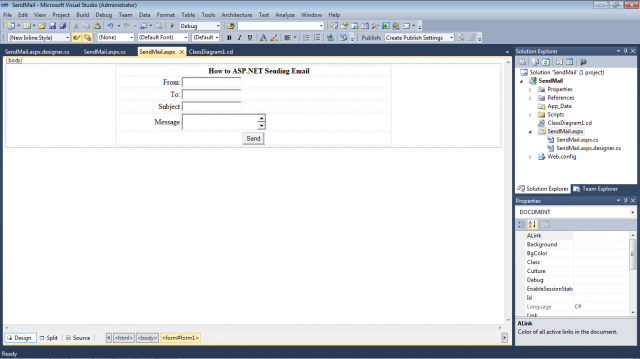In this tutorial you should create a form to allow users to enter e-mail information. When the user submits the form to the server, your application will build a MailMessage object from the email information and then send the email using the SmtpClient class. The namespace System.Net.Mail contains classes which take care of constructing an SMTP-based message. The System.Net.Mail.MailMessages class encapsulated constructing a SMPT-based message, and System.Net.Mail.SmtpClient class provides the mechanism for sending the message to an SMTP server.
In the .aspx file:
- Create a simple form to capture the sender’s email address, the recipient’s email address, the subject, and the message body.
- Add a Send button that initiates the sending of email.
In the code-behind class for the page:
- Create a MailMessage object which will work as a container for the mail message.
- Set the To, From, Subject and Body properties to the data entered on the form.
- Create a SmtpClient object (specifying the SMPTP server) which will send a message. This object will expect in most cases:
- To specify server and port for outgoing e-mail messages. For example you can use smtp.gmail.com and port 587 when you create the object.
- To enable ssl if the smtp server uses it –
- To setup credentials
- Use try/catch block to send a message.
Use Visual Studio to create a new ASP.NET project with name for example SendMail.
The page SendMail.aspx looks like the next picture
and its markup is the following
<%@ Page Language=”C#” AutoEventWireup=”true” CodeBehind=”SendMail.aspx.cs” Inherits=”SendMail.SendMail” %>
<!DOCTYPE html PUBLIC “-//W3C//DTD XHTML 1.0 Transitional//EN” “https://www.w3.org/TR/xhtml1/DTD/xhtml1-transitional.dtd”>
<html xmlns=”https://www.w3.org/1999/xhtml”>
<head runat=”server”>
<title></title>
</head>
<body>
<form id=”form1″ runat=”server”>
<div>
<table style=”width: 56%;” align=”center”>
<tr>
<td align=”center” colspan=”2″ width=”90%”>
<strong>How to ASP.NET Sending Email</strong></td>
</tr>
<tr>
<td align=”right”>
From:</td>
<td align=”left”>
<asp:TextBox ID=”txtFrom” runat=”server”></asp:TextBox>
</td>
</tr>
<tr>
<td align=”right”>
To:</td>
<td align=”left”>
<asp:TextBox ID=”txtTo” runat=”server”></asp:TextBox>
</td>
</tr>
<tr>
<td align=”right”>
Subject</td>
<td align=”left”>
<asp:TextBox ID=”txtSubject” runat=”server”></asp:TextBox>
</td>
</tr>
<tr>
<td align=”right”>
Message</td>
<td align=”left”>
<asp:TextBox ID=”txtMsg” runat=”server” TextMode=”MultiLine”></asp:TextBox>
</td>
</tr>
<tr>
<td align=”center” colspan=”2″>
<asp:Button ID=”btnSend” runat=”server” onclick=”btnSend_Click” Text=”Send” />
</td>
</tr>
</table>
</div>
</form>
</body>
</html>
The code-behind files are the following File SendMail.apsx.cs
using System;
using System.Collections.Generic;
using System.Web;
using System.Web.UI;
using System.Web.UI.WebControls;
using System.Net.Mail;
namespace SendMail
{
public partial class SendMail : System.Web.UI.Page
{
protected void Page_Load(object sender, EventArgs e)
{
this.btnSend.Click += new EventHandler(this.btnSend_Click);
}
protected void btnSend_Click(object sender, EventArgs e)
{
MailMessage emailMsg = new MailMessage(txtFrom.Text, txtTo.Text);
emailMsg.Subject = txtSubject.Text;
emailMsg.Body = txtMsg.Text;
// If you want to attach something uncomment the next lines:
// comment: path to file points to your attachment
//string pathToFile = “c:\\Downloads\\0122_0001.pdf”;
// comment: with media type you can control type of attachment
//Attachment atch = new Attachment(pathToFile, System.Net.Mime.MediaTypeNames.Application.Pdf);
//emailMsg.Attachments.Add(atch);
// Note: smtp.gmail.com is server for outgoing email messages and 587 is its port
SmtpClient client = new SmtpClient(“smtp.gmail.com”, 587);
// Note: gmail uses ssl encrypted connection
client.EnableSsl = true;
client.Credentials = new System.Net.NetworkCredential(“YourUserName@gmail.com”, “YourPassword”);
try
{
client.Send(emailMsg);
}
catch (Exception ex)
{
Console.WriteLine(“Exception caught in SendEmailMessage(): {0}”, ex.ToString());
}
}
}
}
File SendMail.apsx.designer.cs
//——————————————————————————
// <auto-generated>
// This code was generated by a tool.
//
// Changes to this file may cause incorrect behavior and will be lost if
// the code is regenerated.
// </auto-generated>
//——————————————————————————
namespace SendMail {
public partial class SendMail {
/// <summary>
/// form1 control.
/// </summary>
/// <remarks>
/// Auto-generated field.
/// To modify move field declaration from designer file to code-behind file.
/// </remarks>
protected global::System.Web.UI.HtmlControls.HtmlForm form1;
/// <summary>
/// txtFrom control.
/// </summary>
/// <remarks>
/// Auto-generated field.
/// To modify move field declaration from designer file to code-behind file.
/// </remarks>
protected global::System.Web.UI.WebControls.TextBox txtFrom;
/// <summary>
/// txtTo control.
/// </summary>
/// <remarks>
/// Auto-generated field.
/// To modify move field declaration from designer file to code-behind file.
/// </remarks>
protected global::System.Web.UI.WebControls.TextBox txtTo;
/// <summary>
/// txtSubject control.
/// </summary>
/// <remarks>
/// Auto-generated field.
/// To modify move field declaration from designer file to code-behind file.
/// </remarks>
protected global::System.Web.UI.WebControls.TextBox txtSubject;
/// <summary>
/// txtMsg control.
/// </summary>
/// <remarks>
/// Auto-generated field.
/// To modify move field declaration from designer file to code-behind file.
/// </remarks>
protected global::System.Web.UI.WebControls.TextBox txtMsg;
/// <summary>
/// btnSend control.
/// </summary>
/// <remarks>
/// Auto-generated field.
/// To modify move field declaration from designer file to code-behind file.
/// </remarks>
protected global::System.Web.UI.WebControls.Button btnSend;
}
}

